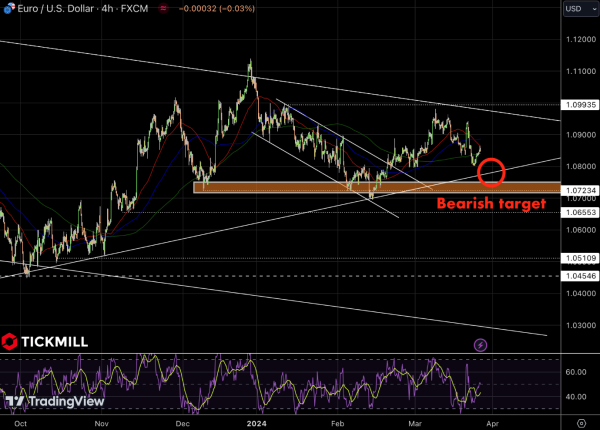The Dollar Rally Stalls as Market Participants Wait for more Signals of the Strength of the US Economy
The EUR/USD pair is showing resilience, defending its near-term support level at 1.08. A broad, albeit slight, dollar weakness contributed to the strength of the pair. However, recent economic data releases from both the United States and Europe have injected fresh dynamics into the forex landscape, influencing market sentiment and shaping expectations regarding central bank policies.
The release of US Durable Goods Orders for February presented a positive surprise, with headline figures surpassing expectations. Headline Durable Goods Orders rose by 1.4%, exceeding the forecast of 1.3%. Moreover, various components, including Durable Goods Orders ex Defense and Nondefense Capital Goods ex Aircraft, outperformed market estimates.
Furthermore, commentary from Federal Reserve officials, particularly Raphael Bostic, President of the Federal Reserve Bank of Atlanta, has been notably hawkish. Bostic's assertion that the Fed is likely to cut interest rates only once in 2024 contrasts with the market's expectation of three cuts. Such comments temper the extent of dollar sell-offs and contribute positively to the upside potential of the currency.
Conversely, European Central Bank officials have adopted a more dovish tone, signaling a potential shift towards earlier interest rate cuts. ECB Member Fabio Panetta's remarks regarding the emerging consensus for a rate cut, possibly as early as June, have weighed on the Euro's outlook. Additionally, ECB Chief Economist Philip Lane's confidence in wage inflation reaching levels consistent with the ECB's target suggests the forthcoming start of a policy easing cycle.
The prospect of lower interest rates in Europe, coupled with the likelihood of a dovish stance from the ECB, reins in upward momentum in the pair. A rate cut in April, as hinted by Panetta, could further undermine the Euro's attractiveness, potentially leading to decreased inflows of foreign capital.
Short-term technical analysis suggests that the resurgence of buying pressure, signaling a potential pullback, may occur specifically around the medium-support line, aligning with the 1.0750 level:

Meanwhile, the Pound Sterling has exhibited strength against the US Dollar, extending its gains above 1.2650. Despite concerns regarding the Bank of England's (BoE) dovish stance, driven by lower-than-anticipated inflation data, the GBP/USD pair has shown resilience. The BoE's recent monetary policy statement indicated a reluctance to reduce interest rates immediately, although market expectations of rate cuts persist.
Technically speaking, the recent price action has seen a breakdown below both the resistance line and the ascending support line, leaving the pair with limited prospects for an immediate recovery. Sellers are likely to target the 1.25 level before considering their triumph, potentially paving the way for bullish momentum thereafter: